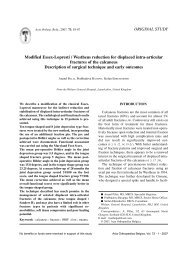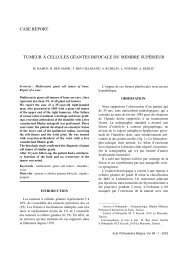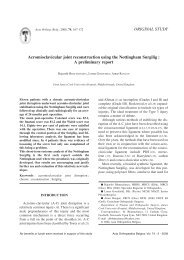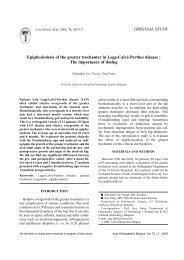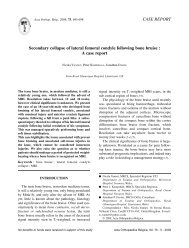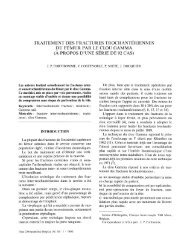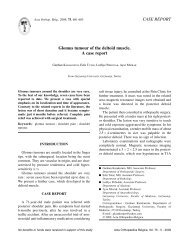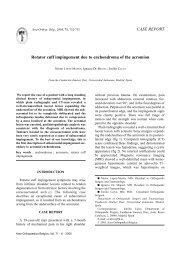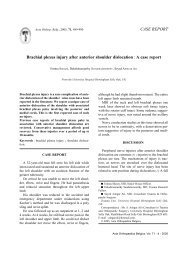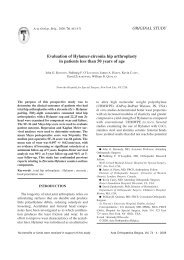Functional reconstruction of the upper extremity in tetraplegia ...
Functional reconstruction of the upper extremity in tetraplegia ...
Functional reconstruction of the upper extremity in tetraplegia ...
You also want an ePaper? Increase the reach of your titles
YUMPU automatically turns print PDFs into web optimized ePapers that Google loves.
538 D. WELRAEDS, A. A. ISMAIL, A. PARENT<br />
PATIENTS AND METHODS<br />
Between 1986 and 2002, we performed 43 operations<br />
for restitution <strong>of</strong> <strong>upper</strong> arm function <strong>in</strong> 25 tetraplegics.<br />
Eighteen were male and 7 female, a common distribution<br />
among patients with a traumatic lesion <strong>of</strong> <strong>the</strong> sp<strong>in</strong>al<br />
cord. The mean age at <strong>the</strong> time <strong>of</strong> <strong>in</strong>jury was 30 years ;<br />
it was 37 years at <strong>the</strong> time <strong>of</strong> operation (range : 15 to 52<br />
years). The time <strong>in</strong>terval between <strong>in</strong>jury and <strong>the</strong> f<strong>in</strong>al<br />
operation was 68 months (range : 7 to 356 months).<br />
Some patients had several consecutive operations on <strong>the</strong><br />
same limb to restore different functions ; o<strong>the</strong>rs had<br />
operations on both <strong>upper</strong> limbs at different sett<strong>in</strong>gs, to<br />
avoid simultaneous immobilisation <strong>of</strong> both sides .<br />
Twenty-four patients had susta<strong>in</strong>ed <strong>the</strong>ir <strong>in</strong>jury <strong>in</strong> an<br />
accident, most <strong>of</strong>ten a road traffic accident (19/24) ; <strong>the</strong><br />
condition was secondary to a neurological pathology<br />
(Guilla<strong>in</strong>-Barré) <strong>in</strong> one patient.<br />
The sp<strong>in</strong>al cord lesion was at <strong>the</strong> C5 level <strong>in</strong> four<br />
patients, <strong>in</strong>clud<strong>in</strong>g two with <strong>in</strong>complete <strong>tetraplegia</strong> ; it<br />
was at <strong>the</strong> C6 level <strong>in</strong> eleven patients, <strong>in</strong>clud<strong>in</strong>g two with<br />
<strong>in</strong>complete <strong>tetraplegia</strong> ; at <strong>the</strong> C7 level <strong>in</strong> eight patients<br />
<strong>in</strong>clud<strong>in</strong>g two with <strong>in</strong>complete <strong>tetraplegia</strong>, and at <strong>the</strong> C8<br />
level <strong>in</strong> two patients.<br />
Five patients had been treated conservatively, <strong>in</strong>clud<strong>in</strong>g<br />
<strong>the</strong> patient with <strong>tetraplegia</strong> secondary to Guilla<strong>in</strong>-<br />
Barré. The o<strong>the</strong>r 20 had been treated surgically : one had<br />
undergone simple lam<strong>in</strong>ectomy, and 19 had undergone<br />
anterior and/or posterior sp<strong>in</strong>e fixation.<br />
Complications occurred after <strong>in</strong>itial admission <strong>in</strong><br />
11 out <strong>of</strong> 25 patients : 9 respiratory, 6 pressure sores,<br />
2 ectopic ossifications, 1 carpal tunnel syndrome, 1 deep<br />
ve<strong>in</strong> thrombosis, 1 nervous breakdown.<br />
Two patients died several years after operation : one<br />
from an unknown cause, <strong>the</strong> o<strong>the</strong>r follow<strong>in</strong>g a fall.<br />
Patient selection<br />
METHODS<br />
Ow<strong>in</strong>g to <strong>the</strong> length and complexity <strong>of</strong> rehabilitation,<br />
we pre fe rred yo u n g, m o t ivated pat i e n t s , able to<br />
understand and endure <strong>the</strong> demands and duration <strong>of</strong> <strong>the</strong>ir<br />
rehabilitation.<br />
Youth is a major asset for both plasticity <strong>of</strong> <strong>the</strong> tissues<br />
and mental adjustment requested for tendon transfers<br />
modify<strong>in</strong>g muscular functions. Never<strong>the</strong>less, we accepted<br />
older patients if motivation appeared adequate.<br />
Moderate spasticity was not a contra-<strong>in</strong>dication ;<br />
stiffness not improved by physio<strong>the</strong>rapy has lead us to<br />
refuse <strong>the</strong> operation : <strong>the</strong> expected functional ga<strong>in</strong> would<br />
be impaired by <strong>the</strong> limitation <strong>in</strong> jo<strong>in</strong>t mobility.<br />
Pressure sores were always considered a contra<strong>in</strong>dication.<br />
Pre- and postoperative evaluation<br />
All patients were submitted to a pre- and postoperative<br />
evaluation (usually done by <strong>the</strong> surgeon <strong>in</strong><br />
charge <strong>of</strong> <strong>the</strong> operation) and, if necessary, to a neurological<br />
assessment made by a neurologist.<br />
Pre-operative evaluation was done a short time before<br />
<strong>the</strong> operat i o n ; post-operat ive eva l u ation was done<br />
before discharge, 12 to 16 weeks after <strong>the</strong> surgery.<br />
Pre-operative evaluation consisted <strong>of</strong> a record <strong>of</strong> <strong>the</strong><br />
patient’s functional needs and motivations, a motor and<br />
sensitive assessment <strong>of</strong> <strong>the</strong> <strong>upper</strong> limbs and a record <strong>of</strong><br />
side issues as spasticity, stiffness, fractures, pa<strong>in</strong>, sk<strong>in</strong><br />
c o n d i t i o n , p s y ch o l ogical stat u s , i n fectious diseases.<br />
Post-operatively complications and patient appreciation<br />
were documented and functional ga<strong>in</strong> evaluated.<br />
Although it was not considered mandat o ry, p re -<br />
o p e rat ive electro p hy s i o l ogical assessment <strong>of</strong> <strong>the</strong><br />
<strong>in</strong>volved muscles was done whenever possible, <strong>in</strong> order<br />
to check <strong>the</strong> <strong>in</strong>tegrity <strong>of</strong> <strong>the</strong> muscles elected for transfer<br />
and confirm <strong>the</strong> permanent loss <strong>of</strong> <strong>the</strong> receiver muscles,<br />
<strong>in</strong> order to appropriately schedule surgery (Bunnell) (3).<br />
Occupational <strong>the</strong>rapists performed functional evaluation<br />
<strong>of</strong> <strong>the</strong> <strong>upper</strong> limb us<strong>in</strong>g Filipetti’s method (5). It<br />
consists <strong>of</strong> Lamb’s autonomy assessment and<br />
Sollermann’s prehension test. Both tests are meant to<br />
give a quantitated rat<strong>in</strong>g <strong>of</strong> common gestures and allow,<br />
through pre- and postoperative comparison, an objective<br />
appraisal <strong>of</strong> functional ga<strong>in</strong> <strong>of</strong> <strong>the</strong> operation. It was<br />
noted that <strong>the</strong>ir reproducibility among various occupational<br />
<strong>the</strong>rapists was poor and although <strong>the</strong>y might serve<br />
as a standard method <strong>of</strong> evaluation <strong>in</strong> expert hands, such<br />
was not <strong>the</strong> case <strong>in</strong> our series.<br />
Operations<br />
Upper limb surgery <strong>in</strong> a proximal level tetraplegic is<br />
planned <strong>in</strong> two stages : restoration <strong>of</strong> <strong>the</strong> spatial control<br />
<strong>of</strong> <strong>the</strong> arm is always <strong>the</strong> first step when elbow extension<br />
is abolished or severely weakened. As a second step<br />
hand function is improved when <strong>the</strong> need is expressed<br />
by <strong>the</strong> patient.<br />
To acquire spatial control <strong>of</strong> <strong>the</strong> arm, it is necessary to<br />
restore, through transfer <strong>of</strong> <strong>the</strong> posterior deltoid to <strong>the</strong><br />
triceps, a useful elbow extension, which is <strong>of</strong>ten abolished<br />
or too weak. This transfer was always done us<strong>in</strong>g<br />
Allieu’s technique (1). An artificial ligament made <strong>of</strong><br />
Dacron is wrapped <strong>in</strong> a sheath <strong>of</strong> fascia lata taken from<br />
Acta Orthopædica Belgica, Vol. 69 -6-2003



